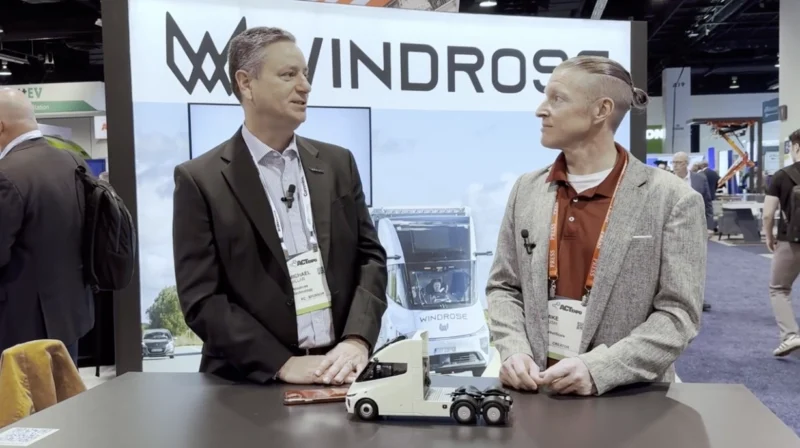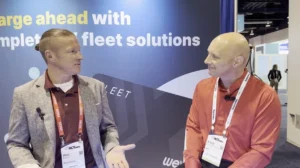Ford Unveils the Electric F-150, Aims to Shake up the EV Market
(Bloomberg) —
Linda Zhang, chief engineer of Ford Motor Co.’s new electric F-150 pickup, steers a 3-ton rig onto a test track at the automaker’s suburban Detroit proving grounds and mashes the accelerator. In about four seconds, she says, “We’re at 60” miles per hour. Then, a heartbeat later as the G-forces bear down, “We’re at 100.”
No wonder Ford calls its newest model the Lightning. Two electric motors give the pickup 563 horsepower capable of propelling its 6,500 pounds at sports-car speed. That’s what President Joe Biden discovered Tuesday as he took it for a spin during a visit to Ford’s Dearborn, Michigan, test track and declared: “This sucker’s quick!”
Yet it can still tow up to 10,000 pounds and jounce through the mud and ruts of an off-road course just like its conventional gas-powered counterpart.
Those speedy and sturdy attributes are the formula Ford is hoping will stand out in a soon-to-be crowded field of electric pickups. By the time the truck goes on sale in the middle of next year, it may already trail the arrival of Tesla Inc.’s Cybertruck, General Motors Co.’s GMC Hummer pickup and Rivian Automotive Inc.’s R1T.
Read more: Your Next Car Will Probably Be an Electric Pickup
Electrifying the F-150, Ford’s golden goose, is critical to the company, which introduced the vehicle during a splashy ceremony at its headquarters on Wednesday, a day after Biden toured the plant that will build it. The gasoline-powered F-Series truck line generates $42 billion in revenue a year — more than McDonald’s, Nike and Starbucks — and hauls in most of Ford’s profit.
“This is an iconic moment for our industry,” Chief Executive Officer Jim Farley said in an interview with Bloomberg Television on Thursday. “We have over 20,000 orders in 12 hours since we revealed right here in Dearborn.”
Earlier, at that flashy introduction, Farley told reporters that the electric F-150 could serve as a proxy for how mainstream buyers will accept battery power. “I am looking at this vehicle as a test for adoption for electric vehicles,” Farley said. “We should all watch very carefully how this does in the market.”
Kumar Galhotra, Ford’s president of the Americas and international markets, said in an interview that it’s “incredibly important that this vehicle be a success for us.”
The F-Series has been the best-selling vehicle line in America for four decades, but Ford isn’t taking that brand loyalty for granted. It remains to be seen if electric pickups from an automotive incumbent will be as attractive to traditional truckers as early EVs have been to tech bros.
“Will they buy from Ford — that’s been a truck-making expert for decades — or will they buy from an upstart because they’re attracted to a new brand?” asks Michelle Krebs, executive analyst for AutoTrader, a unit of researcher Cox Automotive. “We just don’t know.”
Ford shares rose as much as 4.8% on Thursday, the most on an intraday basis since April 5.
Cavernous ‘Frunk’
Ford is looking to improve the odds of making the Lightning a hit. It has set the starting price at just under $40,000 — about the same as a gas-powered F-150 — and created a cavernous “frunk,” or trunk in the front of the vehicle. At the touch of a button on the key fob, the hood and grille lift to reveal more than 14 cubic feet of space that can handle 400 pounds of cargo. It features a deep well with a drain for iced beverages.
“I was surprised that it’s going to start at $40,000, which is actually $2,500 cheaper than a base XL crew cab with four-wheel drive,” said Sam Abuelsamid, principal analyst with researcher Guidehouse Insights, who was briefed on the truck. “And what they’re calling the mega-power frunk seems to have been very well-executed.”
Ford also will bill the Lightning as having competitive driving range of 230 miles on the base model and 300 miles for buyers who pay extra for an extended-range battery. That’s more than Ford is offering in its electric Transit commercial van but less than the 400 miles of range GM is promising in its electric Silverado pickup, which is expected to debut in early 2024.
Ford’s truck uses a lithium-ion battery supplied by South Korea’s SK Innovation Co. The two companies said Thursday they have signed a memorandum of understanding to jointly manufacture batteries in the U.S.
EV Laggard
Scoring a win with an electric F-150 would go a long way toward helping Ford overcome its image as an EV laggard playing catchup to Tesla and GM, which has set a goal of going all-electric by 2035. Farley recently doubled the company’s spending on EVs to $22 billion, but he has yet to detail how many models Ford will roll out or when it will ditch internal combustion engines.
He’s expected to provide some of those answers at an investor meeting on May 26.
“At this stage, GM is still ahead because they’ve committed to 20 EVs for the North American market and 30 globally,” Abuelsamid said. “So far, Ford has shown us three vehicles and they’ve said there’s more coming.”
Ford is taking a different path by converting its best-selling model to an electric vehicle, rather than designing something new from the ground up, as Tesla and GM have done. Ford engineers overhauled the F-150’s frame to accommodate a 1,300-pound battery and two electric motors between the front and rear wheels. But they left intact much of the truck’s design, including its aluminum body and the cab, with the exception of the 15.5-inch touchscreen borrowed from the dashboard of the electric Mustang Mach-E.
By re-purposing so much of the F-150, Ford says it will make money on every Lightning it sells. That also is the secret to its low starting price.
The gas and electric versions of the truck are sharing “a lot of expensive, important parts,” Ted Cannis, general manager of Ford’s North American commercial business, said in an interview. “We could reuse the whole cab. Why do I need to invent all-new seats and door handles?”
Fleet Buyers
That has enabled Cannis to make a price pitch to his commercial customers who manage vast business and government fleets. Those cost-conscious customers — who visited Ford’s proving grounds last week for a private preview of the Lightning — are expected to be big buyers of the vehicle, especially if gasoline prices rise and battery power gains an edge.
“Ford’s strategy is very focused on fleets,” Krebs said. “That’s a smart approach because Biden’s plan is to have government fleets more electrified.”
For individual consumers, Ford has added optional features such as hands-free driving technology and electronic scales to weigh the cargo in the truck bed. There’s even a power-backup option that can divert electricity from the truck to keep juice flowing to a home for as long as three days in a blackout.
Ford didn’t provide the cost of for those options, but they will drive sticker prices up to $90,000 for the top-end Platinum Lightning.
“That $40,000 price is just the starting point,” Abuelsamid said. “Average transaction prices are going to be a lot higher.”
–With assistance from David Westin and Ed Ludlow.









